Physical Address
304 North Cardinal St.
Dorchester Center, MA 02124
Physical Address
304 North Cardinal St.
Dorchester Center, MA 02124
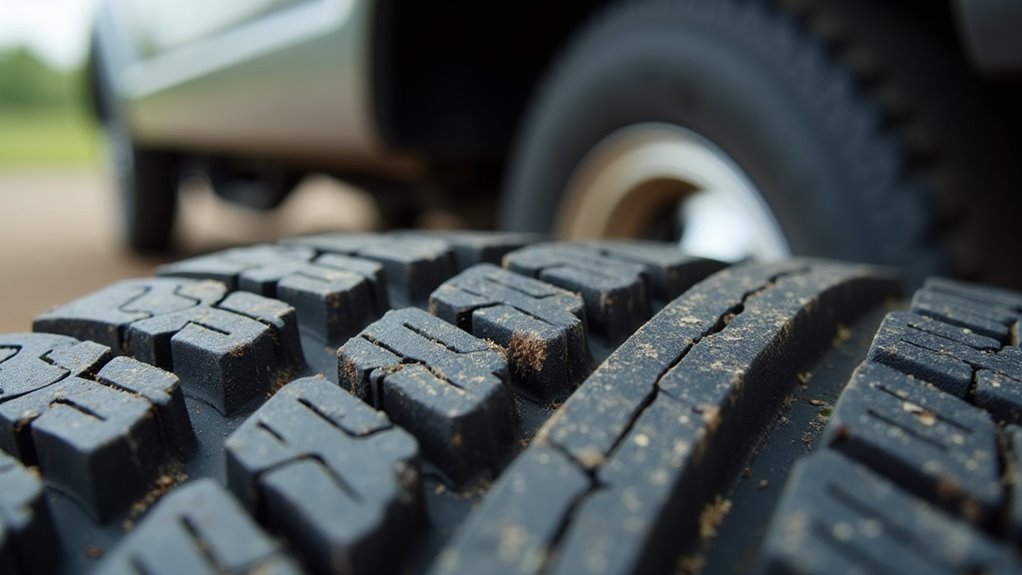
Nobody expects their RV vacation to end with a dangerous blowout, but skipping tire maintenance could lead to exactly that scenario.
You’ve probably wondered whether your RV really needs the same tire maintenance as your regular vehicle. The short answer is yes – but there’s more to reflect upon. RVs face unique challenges that make balancing and rotating tires even more critical than you might think. From uneven weight distribution to extended periods of storage, your recreational vehicle puts different demands on its tires. Understanding these specific needs could save you from costly repairs and dangerous situations down the road.
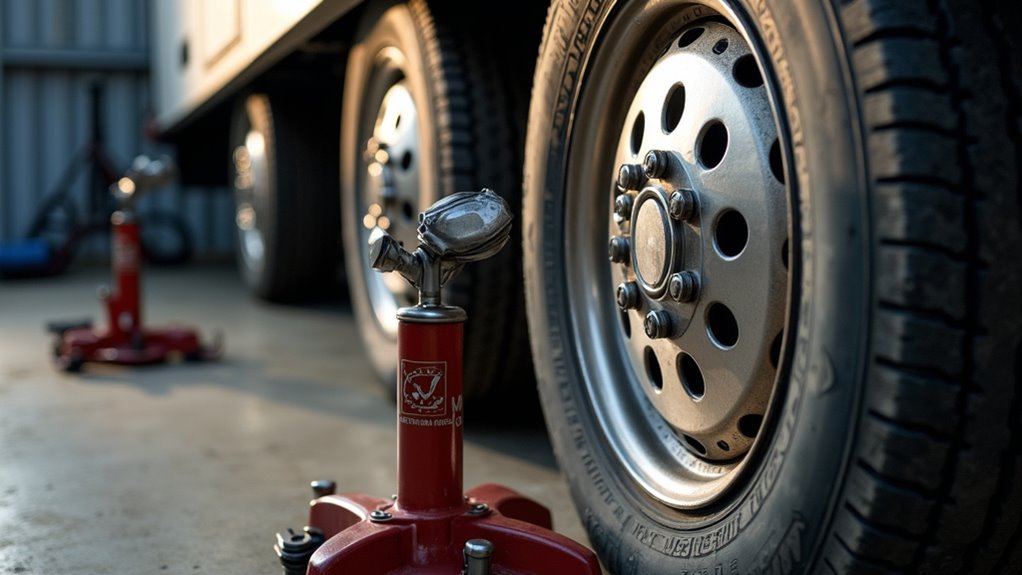
While your RV’s tires don’t spin as fast as your car’s, they still need proper balancing to prevent costly problems down the road. Tire balancing eliminates heavy spots that cause vibrations, which can damage your RV’s suspension components and reduce tire life considerably.
You’ll encounter two main balancing methods: static and dynamic. Static balancing uses a bubble level and weights on the rim, while dynamic balancing involves spin tests for high-speed accuracy. Dynamic balancing is more effective but requires specialized equipment. However, high-speed spin balance isn’t recommended for RVs due to potential tire wear.
Properly balanced tires deliver multiple benefits for your RV. You’ll experience smoother rides with less vibration, improved fuel efficiency, and enhanced safety at highway speeds.
Balanced RV tires mean smoother highway travel, better fuel economy, and safer journeys for you and your family.
Your tires will also wear more evenly, extending their lifespan and saving you money on premature replacements.
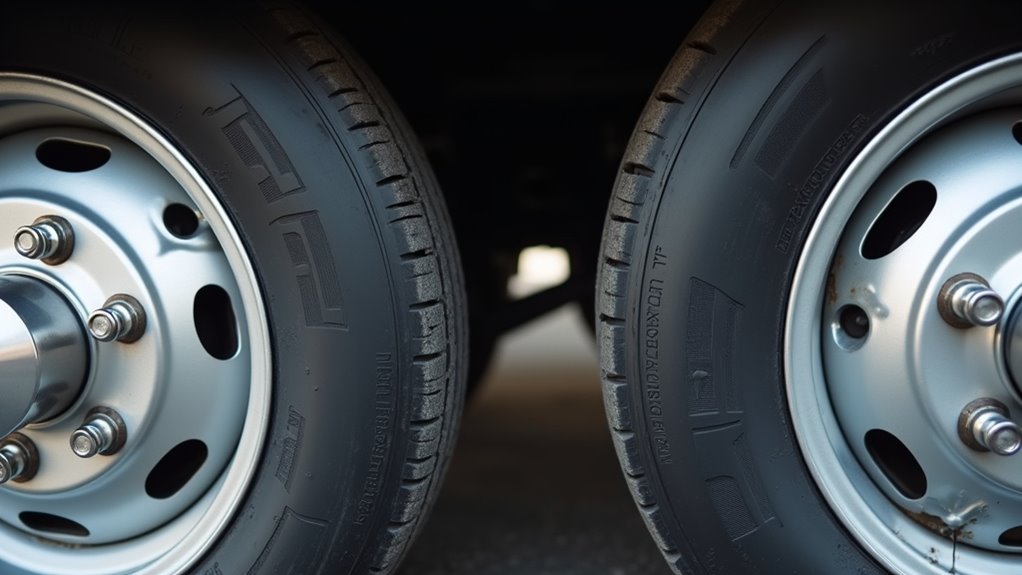
Five key benefits make tire rotation essential for maximizing your RV’s tire investment and road safety.
First, rotation promotes uniform tread wear by ensuring each tire experiences different stress patterns, preventing premature replacement since front tires typically wear faster due to steering and weight distribution.
Second, you’ll maintain consistent vehicle handling and safety through balanced traction and improved braking performance while reducing blowout risks.
Third, regular rotation keeps your tire warranty valid—manufacturers require documented rotations every 3,000–5,000 miles.
Fourth, evenly worn tires improve fuel efficiency by maintaining consistent rolling resistance across all positions. However, tires typically age out before they wear out, with an average lifespan of approximately 7-8 years.
Finally, rotation helps identify alignment or suspension problems early, saving you costly repairs down the road.
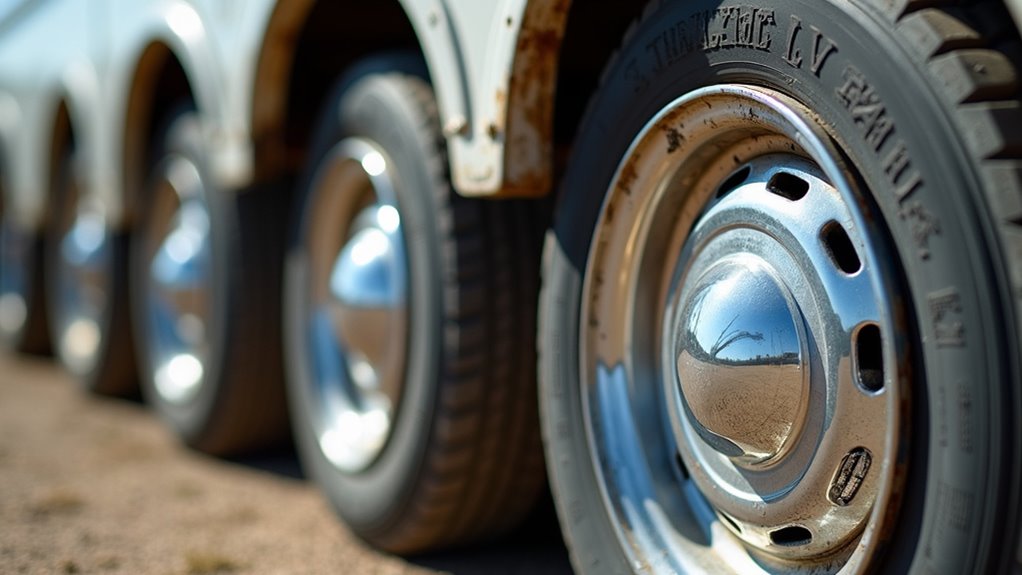
When you combine tire balancing and rotation services for your RV, you’re addressing two critical maintenance needs that work together to maximize your tire investment.
Balancing corrects weight distribution issues that cause vibrations and irregular wear, while rotation guarantees each tire experiences different stress patterns for uniform aging across your entire set.
This combined approach delivers extensive benefits that neither service can achieve alone:
RVs require more frequent attention than standard vehicles due to their increased weight, with experts recommending tire rotation every 4,000 to 6,000 miles to account for the additional stress placed on these heavy-duty tires.
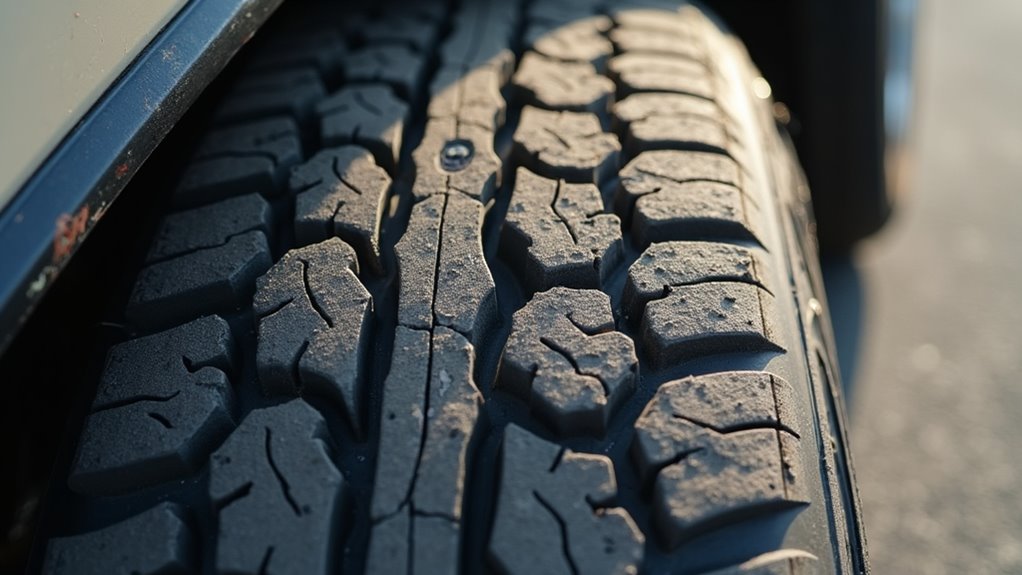
Your RV’s tires communicate their condition through specific warning signs that shouldn’t be ignored.
Visual cues like bulges, bubbles, sidewall cracks, or deep tire cracks indicate immediate replacement needs. Check your tread depth—anything less than 2/32 inches requires new tires.
Pay attention to performance issues while driving. If you’re experiencing vibrations, pulling, or unstable handling, your tires may be damaged or improperly balanced.
Uneven tread wear patterns signal alignment problems or overloading. With approximately 11,000 tire-related crashes occurring annually according to NHTSA data, maintaining proper tire condition is critical for road safety.
Don’t forget about age. Even if they look fine, tires older than 5-7 years should be replaced due to rubber degradation.
Check the DOT code on your sidewall to determine manufacture date. Regular inspections at every stop help catch problems early, preventing dangerous blowouts and costly roadside emergencies.
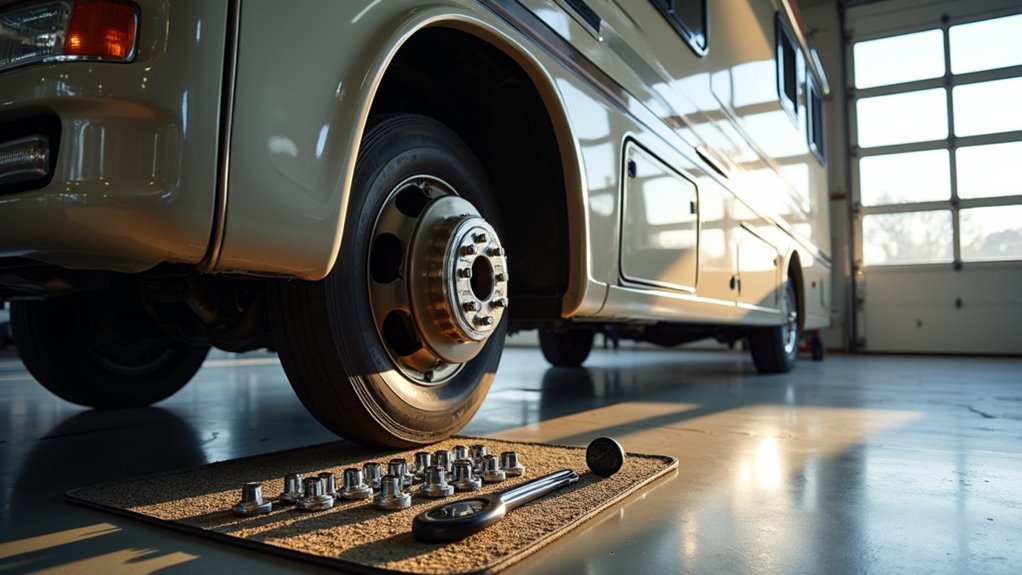
Establishing a consistent maintenance schedule keeps your RV tires performing at their best and helps you avoid costly replacements down the road.
You’ll want to rotate your tires every 3,000 to 8,000 miles, depending on your RV’s specifications and driving conditions.
Don’t rely solely on mileage intervals—inspect your tires regularly for uneven wear patterns that might indicate you need more frequent rotations or alignment adjustments.
Your maintenance routine should include these essential practices:
Always consult your owner’s manual for manufacturer-specific recommendations. Remember to measure tire pressure when tires are cold to ensure the most accurate readings.

How do you determine which balancing method will keep your RV’s tires performing smoothly mile after mile? Your choice depends on your RV’s weight and typical driving speeds.
Static balancing works for lightweight applications and corrects vertical imbalances using weights on one plane. It’s simple and fast but won’t handle the demands of heavy RVs at highway speeds.
Dynamic balancing is your better bet for most RVs. It corrects both vertical and lateral imbalances by placing weights on both inside and outside tire planes. This method simulates actual road conditions, delivering smoother rides and better tire wear patterns. Operator error often contributes to balancing issues, so ensure your technician has proper training and experience with RV tire balancing procedures.
Since RVs are heavy and often travel at highway speeds, dynamic balancing provides superior steering stability, reduces vibration, and extends both tire life and suspension component longevity.
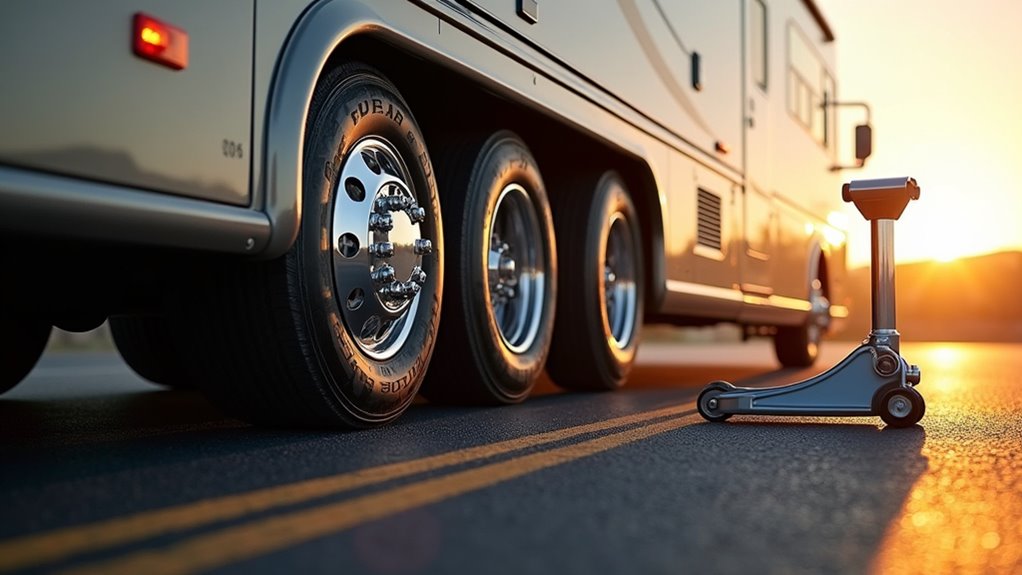
Proper tire balancing sets the foundation, but rotating your RV’s tires according to the right pattern maximizes their lifespan and performance.
Your RV’s drivetrain determines which rotation pattern you’ll use. FWD RVs need the forward cross pattern, while RWD and 4WD configurations work best with the rearward cross pattern. AWD and 4WD systems benefit most from the X-pattern rotation. Understanding your vehicle specifications helps ensure you select the most effective rotation method for your particular RV setup.
Key rotation patterns to remember:
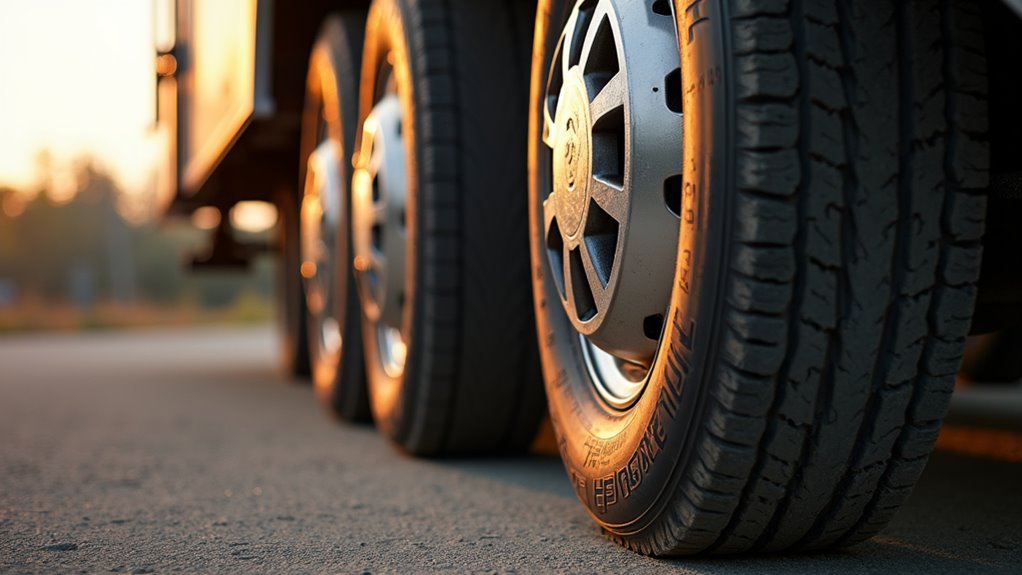
While the upfront costs of regular tire maintenance might seem like an unnecessary expense, you’ll actually save thousands of dollars over your RV’s lifetime by staying on top of balancing and rotation schedules.
Neglecting tire care leads to premature replacements, increased fuel consumption, and costly breakdowns that can strand you far from home.
Regular rotation extends your tire lifespan by ensuring even tread wear, while proper balancing reduces stress on axles and bearings.
You’ll see improved fuel efficiency and fewer unexpected repairs. Well-maintained tires also protect your RV’s resale value and reduce insurance liability risks.
Since routine maintenance forms a significant portion of total RV ownership costs, proper tire care becomes an essential component of your overall maintenance budget strategy.
The math is simple: spending a few hundred dollars annually on tire maintenance prevents thousands in replacement costs, emergency repairs, and related expenses down the road.
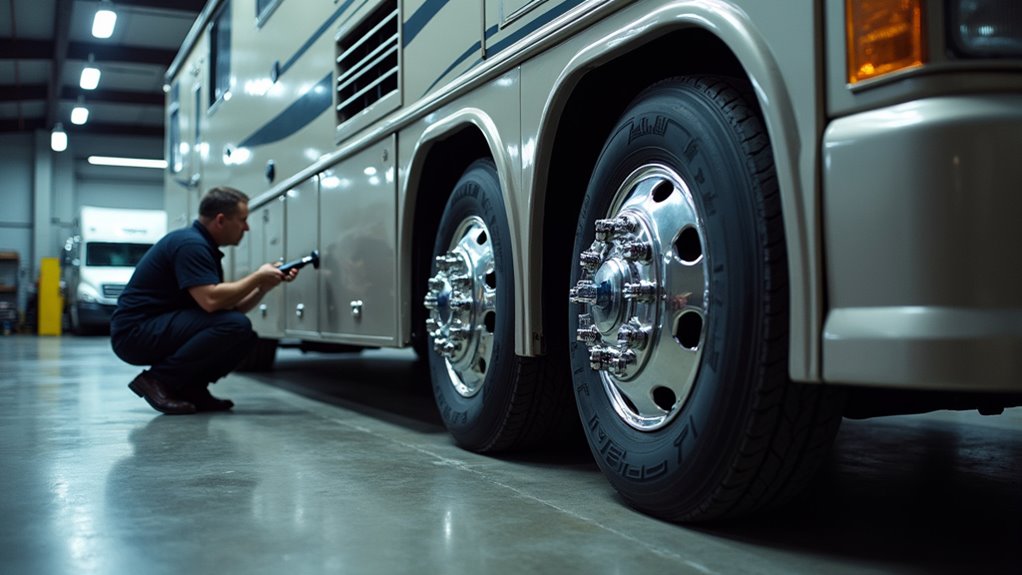
Beyond the financial advantages, maintaining properly balanced and rotated RV tires directly impacts three critical aspects of your travel experience: safety, fuel economy, and overall vehicle reliability.
When you rotate your tires regularly, you’re maintaining consistent traction and handling performance across all four corners of your RV. This prevents dangerous blowouts at highway speeds and guarantees predictable braking distances.
You’ll also notice improved fuel efficiency as even tread wear reduces rolling resistance, cutting your operating costs on long trips.
Regular rotation protects your RV’s suspension and steering components from uneven stress while preventing premature tire failures that could leave you stranded. Professional rotation services also provide an opportunity for comprehensive inspection of your tire condition, allowing technicians to identify potential issues before they become costly problems.
Uneven tire wear creates dangerous stress on your RV’s vital systems and increases the risk of catastrophic roadside breakdowns.
You’ll find it’s no coincidence that RVs with well-maintained tires glide smoothly down highways while neglected ones shake and shudder. Just as a balanced wheel spins effortlessly, your maintenance routine should rotate seamlessly between balancing and rotation services. When you invest those few hundred dollars every 5,000 miles, you’re not just maintaining tires—you’re protecting thousands in potential repairs. Your RV’s performance, your wallet, and your safety all roll together perfectly.